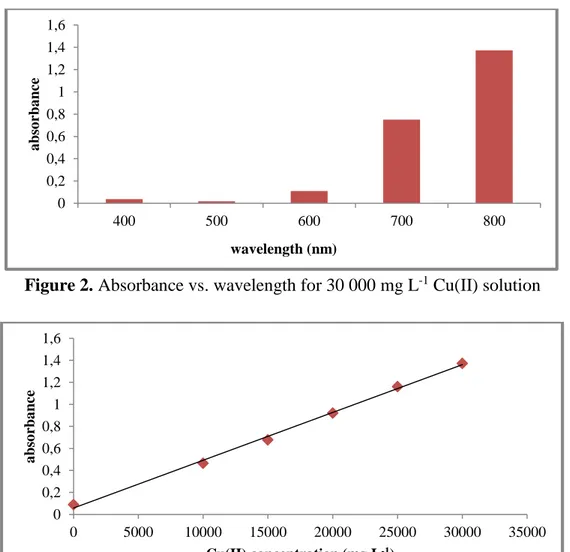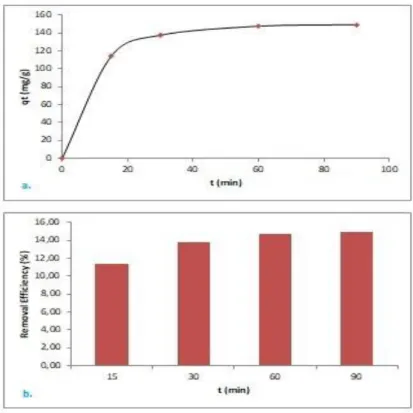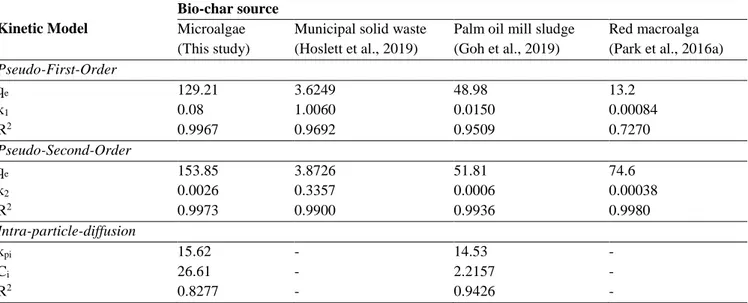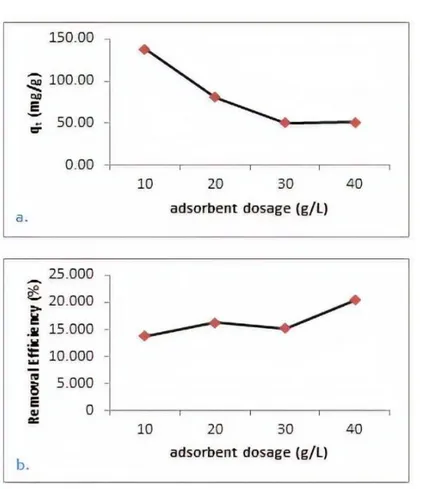DOI: 10.21597/jist.599528 ISSN: 2146-0574, eISSN: 2536-4618
Adsorption of Cu(II) from aqueous solution by using pyrolytic bio-char of Spirulina Gamze ÖZÇAKIR1*
ABSTRACT: Effect of microalgal pyrolytic bio-char on the copper ions removal from water was investigated. Scanning Electron Microscope (SEM) and elemental analysis were done for bio-char before the adsorption experiments. Adsorbent dosage (10-40 g L-1), copper concentration (10 000-20 000 mg L-1), time (15-90 min) parameters were changed. UV visible spectrometer was used to analyze the results. The most adjustible kinetic and adsorption model with data were specified as Pseudo-Second-Order and Freundlich respectively. Maximum adsorption capacity and removal efficiency were found as nearly 150 mg Cu(II) g-1 bio-char and 20% respectively.To characterize the char after the adsorption, it was took the advantage of fouirer transform infrared spectrophotometer (FTIR). Keywords: Microalgae, pyrolysis, bio-char, water purification, heavy metal adsorption
1 Gamze ÖZÇAKIR (Orcid ID: 0000-0003-0357-4176), Bilecik Şeyh Edebali Üniversitesi, Mühendislik Fakültesi, Kimya
Mühendisliği Bölümü, Bilecik, Türkiye
*Sorumlu Yazar/Corresponding Author: Gamze ÖZÇAKIR, e-mail: gamze.ozcakir@bilecik.edu.tr
Geliş tarihi / Received: 31-07-2019 Kabul tarihi / Accepted: 07-11-2019
INTRODUCTION
Biomass has came to the forefront as an alternative energy source to fossil fuels (petroleum, charcoal and natural gas) (Semelsberger et al., 2006). Agricultural and industrial wastes can be used as biomass (Salema et al., 2019). Besides that plants such as microalgae has drawn attention of the researchers because of its unique properties. Microalgae can be grown in the laboratuary with desired properties under controlable conditions and their grown period is quite short (Xie et al., 2015).
Energy production from microalgae can be made by using two different methods. In the biochemical method, the aim is to product fuel like bioethanol and biodiesel. In the thermochemical method like pyrolysis; gas, liquid and solid products can be obtained from microalgae (Chiaramonti et al., 2017).
Bio-char is the solid product of microalgae pyrolysis. It has porous structure and it composes of highly carbon atoms. Physicochemical properties of algal bio-char are affected by pyrolysis temperature and heating rate significantly (Suliman et al., 2016).
Metals whose density are more than 5 g cm-3 can be classified as heavy metals like lead (Pb), cadminium (Cd) and copper (Cu). Heavy metals cause toxicity and pollution on the environment since they can not disappear naturally (Wang et al., 2019).
To remove heavy metal ions from water, several methods like chemical precipitation, electrocoagulation, filtration, solvent extraction, ion exchange and adsorption can be applied to the solution (Inyang et al., 2016). In adsorption technique, it is important to select the adsorbent whose properties are harmlessness, cheapness, insolubility in water (Zhang et al., 2016). Biochar possesses the whole desired features. Bio-chars which were obtained with pyrolysis of several feedstocks have been used commonly for heavy metal removal in recent years (Komkiene and Baltrenaite, 2016; Hodgson et al., 2016; Park et al., 2016b; Qian et al., 2016; Xiao et al. 2017; Hass and Lima, 2018).
Within the scope of the study, effect of residual bio-char on the copper ion removal from aqueous solution at room temperature was examined. SEM and elemental analysis were used to detect morphological properties of the pyrolysis char. UV-vis analysis were used to characterise the solution after the adsorption experiments.
MATERIALS AND METHODS Biochar Synthesis
Spirulina sp. Microalgae was purchased from a local herbalist in dry and powder form. Particle
size measurement of Spirulina was made by using Malvern Mastersizer 2000 Particle Size Analyzer. According to the analysis results, average particle size of the sample was detected 37 µm by volume.
Pyrolysis of Spirulina was carried out in a semi-batch glass reactor system. Experiments were performed in 25 mL min-1 nitrogen atmosphere with 15 g feedstock during 60 min. Temperature was adjusted as 470 and 520°C with Protherm brand PID controller whose heating rate was 10°C min-1. Obtained biochars were labelled as B470 and B520 with respect to pyrolysis temperature. Bio-char yield was calculated by using Eq. 1.
Bio-char yield (%) =
(Feedstock + Reactor, g) after the experiment
− (Feedstock + Reactor, g) before the experiment (Feedstock, g) before
the experiment
Biochar Characterization
Elemental analysis of Spirulina feedstock, B470 and B520 were performed by utilizing Leco brand and CHN628 model with Sulfur add-on module equipment. Result of the analysis was shown in Table 1.
Table 1. Comparision of bio-char and feedstock compositions for Spirulina (ash free and dry basis)
Elements (%, wt./wt.) Spirulina Feedstock B470 B520
C 46.69 56.31 58.17 H 6.22 1.87 1.98 N 10.76 10.38 10.10 S 1.55 0.00 0.00 O* 34.78 31.44 29.76 * by difference
Morphologies of bio-char products were determined by SEM. Before analysis, B470 sample were covered with Au and Pd blend by Quorum Q150R under argon atmosphere. Analysis was made by ZEISS (Supra 40VP). Order of magnitude was choosen for powder form bio-char as 66. Before B470 and B520 were tried in adsorption study, their particle sizes were reduced under 0.425 mm with a stainless steel sieve.
Figure 1. SEM images for B470 Adsorption Procedure
As a Cu(II) source, it was utilized Cu(NO3)2.3H2O (Mw = 241.6 g mol-1) water soluble salt whose brand was Merck. 100 mL 50 000 mg Cu(II) L-1 stock solution was prepeared. Then, 10 mL each of 10 000; 15 000; 20 000; 25 000; 30 000 mg L-1 solutions were formed in pyrex volumetric flasks 25 mL in volume. At room temperature, pH of the solutions was measured with Mettler Toledo SevenCompact™ pH meter (S210 model) and the results were given in Table 2.
Table 2. pH values of Cu(II) solutions (25°C, 1 atm) Cu(II) concentration (mg L-1) pH 10 000 4.73 15 000 4.57 20 000 4.44 25 000 4.32 30 000 4.23
Before the adsorption experiments, it was detected that maximum absorbance value for prepared Cu(II) solutions by utilizing Agilent Cary 60 UV-Vis Spectrophotometer (Figure 2). After it was determined that 800 nm wavelength is suitable for the solutions, it was formed a graph to identify the absorbance values of each solution at 800 nm wavelength (Figure 3). Hereby, it was possible to pass absorbance value for any copper concentration by utilising the Eq. 2. Stuart brand and SSL1 model orbital shaker equipment was settled for the adsorption experiments.
Absorbance = (4*10-5)*Concentration + 0.0578 (2)
Figure 2. Absorbance vs. wavelength for 30 000 mg L-1 Cu(II) solution
Figure 3. Concentration vs. absorbance values for each solution at 800 nm 0 0,2 0,4 0,6 0,8 1 1,2 1,4 1,6 400 500 600 700 800 a bs o rba nce wavelength (nm) 0 0,2 0,4 0,6 0,8 1 1,2 1,4 1,6 0 5000 10000 15000 20000 25000 30000 35000 a bs o rba nce Cu(II) concentration (mg L-1)
Kinetic Study
As an adsorbent, bio-char yield rose from 28.7 to 32.8 with fall in temperature from 520 to 470°C in pyrolysis experiments.
Four solutions whose Cu(II) concentration and volume were 10 000 mg L-1 10 mL respectively were prepared for kinetic experiments. Before the experiments, 0.1 g B520 was added to each of the solutions. First solution was shaked for 15 min. Second one was shaked for 30 min. Third one was shaked for 60 min. And the last one was shaked for 90 min. By utilizing these datas, the most suitable kinetic model (Pseudo-first-order, Pseudo-second-order, Intra-particle diffusion) and equilibrium time were selected for the char in the copper removal. Statements of the kinetic models were given in Eq. 3, Eq. 4 and Eq. 5 for Pseudo-First-Order, Pseudo-Second-Order and Intra-particle-diffusion respectively. In these models, adsorption capacity at equilibrium time was symbolised as qe whose unit was mg g-1. Kinetic model constants was labelled as k1, k2, kpi and Ci whose units were min-1, g mg-1 min-1, mg g-1 min-1/2 and mg g-1 respectively. Adsorption capacity and copper removal efficiency were computed with the Eq. 6 and Eq. 7. In Eq. 6, t, qt, C0, Ct, W, V were given as time in min, adsorption capacity at time t in mg g-1, initial concentration of solution in mg L-1, concentration of solution at time t in mg L -1, weight of adsorbent in g and volume of the solution in L respectively.
log(qe-qt) = log(qe)-( k1 2.303)*t (3) t qt = 1 k2 ∗ qe2 + ( 1 qe)*t (4) qt = kpi*t1/2 + Ci (5) qt = (C0− Ct W ) ∗ V (6) Removal efficiency (%) = (C0− Ct C0 ) ∗ 100 (7) Adsorption Isotherm
After the kinetic experiments, 10 mL each of 10 000; 15 000; 20 000 mg L-1 three solution was subjected to the adsorption with 0.1 g B520 throughout the specified equilibrium time. By using these datas, the most suitable adsorption isotherm (Langmuir, Freundlich) was found. Statements of the isotherms were given in Eq. 8, Eq. 9 for Freundlich and Langmuir respectively. Units of the adsorption isoterms were given as L mg-1 for kL, mg g-1 for kF. In the formula of Freundlich isotherm, n represented unitless constant. In addition to that, qm was the symbol of maximum capacity of adsorbent and its unit was in mg g-1.
log(qe) = log(kF)- ( 1 n)*log(Ce) (8) 1 qe = ( 1 kL ∗ qm) ∗ 1 Ce + 1 qm (9)
Effect of adsorbent dosage
Four solutions whose Cu(II) concentration and volume were 10 000 mg L-1 10 mL respectively were prepared for the experiments. Each solution was contained different B520 amount as 0.1, 0.2, 0.3 and 0.4 g. The solutions were shaked during 30 min.
Effect of pyrolysis temperature
Two solutions whose Cu(II) concentration and volume were 10 000 mg L-1 10 mL respectively were prepared for the experiments. Each solution was contained 0.4 g bio-char which was B520 and B470. After the study FTIR analysis was done for B470 with Agilent brand Cary 630 model equipment.
RESULTS AND DISCUSSION Kinetic Study
Concentration values after the experiments were obtained by utilising Eq. 2. Then qt and efficiency values were calculated with Eq. 6 and 7 respectively. In Figure 4, the data was shown. It was detected that qt value, which represented removed mg Cu(II) per g bio-char, nearly did not effect with duration time after 60 min. Because the value at 60 min which was 147.5 mg g-1 was selected as equilibrium adsorption capacity. That adsorption capacity was found high in comparision with adsorption capacity of macroalga bio-char which was 80 mg g-1 (Bordoloi et al., 2017). Copper removal percentage from the aqueous solution in that time was 14.75.
Figure 4. Change in adsorbate amount (a.) and Cu(II) removal efficiency (b.) with time To determine the most logical kinetic model, the data was adjusted to the equation which was given in Eq. 3, Eq. 4 and Eq. 5. Hence, the equation of regression line for each model was indicative to specify the constant for each kinetic model. It was decided to the most logical one by considering R-square values. Graphical demonstration and the constant of the models were shown in Fig. 5 and Table
3 respectively. Considering Table 3, the most logical kinetic model was selected as Pseudo-Second-Order for Spirulina bio-char. In Table 3, it was demonstrated the kinetic results of other studies about Cu(II) removal for a few bio-char as well. Like that study, Pseudo-Second-Order kinetic model was determined as the favourite one for the bio-chars by researchers.
Figure 5. Representation of the kinetic data for Pseudo-First-Order (a.), Pseudo-Second-Order (b.) and
Intra-Particle-Diffusion (c.)
Table 3. Comparision of computed constants and R-square values for kinetic models in this study with the others Kinetic Model
Bio-char source
Microalgae (This study)
Municipal solid waste (Hoslett et al., 2019)
Palm oil mill sludge (Goh et al., 2019)
Red macroalga (Park et al., 2016a)
Pseudo-First-Order qe k1 R2 129.21 0.08 0.9967 3.6249 1.0060 0.9692 48.98 0.0150 0.9509 13.2 0.00084 0.7270 Pseudo-Second-Order qe 153.85 3.8726 51.81 74.6 k2 0.0026 0.3357 0.0006 0.00038 R2 0.9973 0.9900 0.9936 0.9980 Intra-particle-diffusion kpi 15.62 - 14.53 - Ci 26.61 - 2.2157 - R2 0.8277 - 0.9426 -
Adsorption Isotherm
To determine the most logical adsorption isotherm model, the data was adjusted to the equation which was given in Eq. 8 and Eq. 9. Hence, the equation of regression line for each model was indicative to specify the constant for each isotherm model. It was decided to the most logical one by considering R-square values. Graphical demonstration and the constant of the models were shown in Fig. 6 and Table 4 respectively. Considering Table 4, the most logical isotherm model was choosen as Freundlich. Bordoloi and co-workers was also reached the same result. Freundlich was the most suitable isotherm model for algal bio-char in metal removal, i.e.
Figure 6. Representation of the adsorption data for Freundlich (a) and Langmuir (b)
Effect of Adsorbent Dosage
It was deduced that increase in adsorbent dosage for 10 000 mg L-1 copper solution decreased adsorbent capacity significantly. As shown in Fig 7 (a), after it was surpassed 30 g L-1 dosage, it was not detected any alteration in qt value. However, removal efficiency affected positively due to increase in the dosage. As shown in Fig 7 (b.), efficiency increased nearly 5% when the dosage was increased to 40 from 10 g L-1.
Table 4. Comparision of computed constants and R-square values for isotherm models in this study with the other
Isotherm Model Microalgae (This study) Microalgae (Bordoloi et al., 2017) Freundlich n 0.27 1.004 kF 7.93*1016 0.136 R2 0.8504 0.9981 Langmuir qm 4 0.672 kL -1.1*10-4 0.014 R2 0.5684 0.6680
Figure 7. Adsorbent dosage versus qt (a.) and removal efficiency (b.) Effect of Pyrolysis Temperature
Relative to B520, B470 reduced to qt and efficiency values slightly. It was shown in Fig 8. Besides that, FTIR analysis result was given in Fig. 9. Characteristic peaks for Spirulina bio-char were detected as the work whose Leng et al., 2015. Hence, it was deduced that after adsorption, chemical structure of the bio-char did not destroy.
Figure 8. Pyrolysis temperature of bio-char versus qt and removal efficiency 0 20 40 60 470 520 Temperature (°C) removal efficiency (%) qt (mg/g) 91 96 101 0 500 1000 1500 2000 2500 3000 3500 4000 4500 Tr an sm itt an ce (% ) Wavenumber (cm-1)
CONCLUSION
Biochar which was obtained with pyrolysis of Spirulina was tested in Cu(II) adsorption from the aqueous solution. Removal efficiency was determined as 20% for the non-pretreated bio-char. It was obtained that 50 mg Cu(II) ion was able to removed per g adsorbent. The most suitable kinetic and isotherm model were found as Pseudo-Second-Order (R2 = 0.9973) and Freundlich (R2 = 0.8504) respectively.
REFERENCES
Bordoloi N, Goswami R, Kumar M, Kataki R, 2017. Biosorption of Co (II) from Aqueous Solution Using Algal Biochar: Kinetics and Isotherm Studies. Bioresource technology, 244: 1465-1469. Chiaramonti D, Prussi M, Buffi M, Rizzo M, Pari L, 2017. Review and Experimental Study on
Pyrolysis and Hydrothermal Liquefaction of Microalgae for Biofuel Production. Applied Energy, 185: 963-972.
Goh L, Sethupathi S, Bashir J, Ahmed W, 2019. Adsorptive Behaviour of Palm Oil Mill Sludge Biochar Pyrolyzed at Low Temperature for Copper and Cadmium Removal. Journal of environmental management, 237: 281-288.
Hass A, Lima M, 2018. Effect of Feed Source and Pyrolysis Conditions on Properties and Metal Sorption by Sugarcane Biochar. Environmental Technology and Innovation, 10: 16-26.
Hodgson E, Lewys-James A, Ravella R, Thomas-Jones S, Perkins W, Gallagher J, 2016. Optimisation of Slow-Pyrolysis Process Conditions to Maximise Char Yield and Heavy Metal Adsorption of Biochar Produced from Different Feedstocks. Bioresource technology, 214: 574-581.
Hoslett J, Ghazal H, Ahmad D, Jouhara H, 2019. Removal of Copper Ions from Aqueous Solution Using Low Temperature Biochar Derived from the Pyrolysis of Municipal Solid Waste. Science of the Total Environment, 673: 777-789.
Inyang I, Gao B, Yao Y, Xue Y, Zimmerman A, Mosa A, Cao X, 2016. A Review of Biochar as a Low-Cost Adsorbent for Aqueous Heavy Metal Removal. Critical Reviews in Environmental Science and Technology, 46(4): 406-433.
Komkiene J, Baltrenaite E, 2016. Biochar as Adsorbent for Removal of Heavy Metal Ions [Cadmium (II), Copper (II), Lead (II), Zinc (II)] from Aqueous Phase. International Journal of Environmental Science and Technology, 13(2): 471-482.
Leng J, Yuan Z, Huang J, Wang H, Wu B, Fu H, Zeng M, 2015. Characterization and Application of Bio-Chars from Liquefaction of Microalgae, Lignocellulosic Biomass and Sewage Sludge. Fuel Processing Technology, 129: 8-14.
Park H, Cho J, Ryu C, Park K, 2016a. Removal of copper (II) in aqueous solution using pyrolytic biochars derived from red macroalga Porphyra tenera. Journal of Industrial and Engineering Chemistry, 36 : 314-319.
Park H, Ok S, Kim H, Cho S, Heo S, Delaune D, Seo C, 2016b. Competitive adsorption of heavy metals onto sesame straw biochar in aqueous solutions. Chemosphere, 142: 77-83.
Qian L, Zhang W, Yan J, Han L, Gao W, Liu R, Chen M, 2016. Effective removal of heavy metal by biochar colloids under different pyrolysis temperatures. Bioresource Technology, 206 : 217-224. Salema A, Ting W, Shang K, 2019. Pyrolysis of blend (oil palm biomass and sawdust) biomass using
TG-MS. Bioresource Technology, 274: 439-446.
Semelsberger A, Borup L, Greene L, 2006. Dimethyl ether (DME) as an alternative fuel. Journal of Power Sources, 156(2) : 497-511.
Suliman W, Harsh B, Abu-Lail I, Fortuna M, Dallmeyer I, Garcia-Perez M, 2016. Influence of feedstock source and pyrolysis temperature on biochar bulk and surface properties. Biomass and Bioenergy, 84: 37-48.
Wang B, Bai Z, Jiang H, Prinsen P, Luque R, Zhao S, Xuan J, 2019. Selective heavy metal removal and water purification by microfluidically-generated chitosan microspheres: Characteristics, modeling and application. Journal of Hazardous Materials, 364 : 192-205.
Xiao Y, Xue Y, Gao F, Mosa A, 2017. Sorption of heavy metal ions onto crayfish shell biochar: effect of pyrolysis temperature, pH and ionic strength. Journal of the Taiwan Institute of Chemical Engineers, 80: 114-121.
Xie Q, Addy M, Liu S, Zhang B, Cheng Y, Wan Y, Ruan R, 2015. Fast microwave-assisted catalytic co-pyrolysis of microalgae and scum for bio-oil production. Fuel, 160 : 577-582.
Zhang L, Zeng Y, Cheng Z, 2016. Removal of heavy metal ions using chitosan and modified chitosan: A review. Journal of Molecular Liquids, 214 : 175-191.





